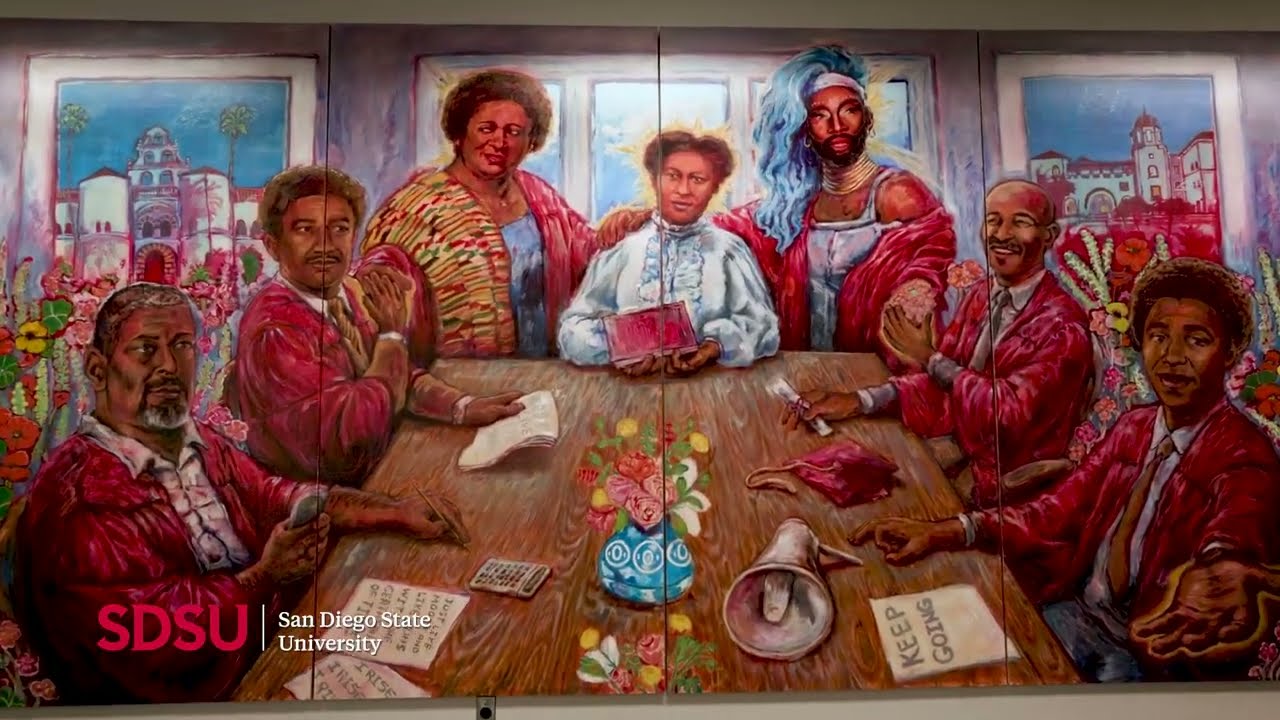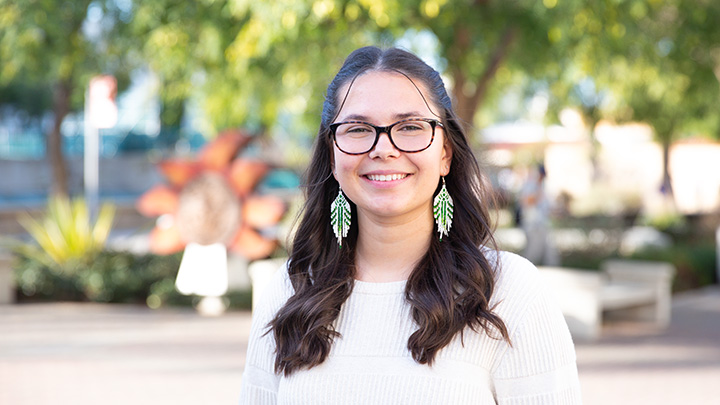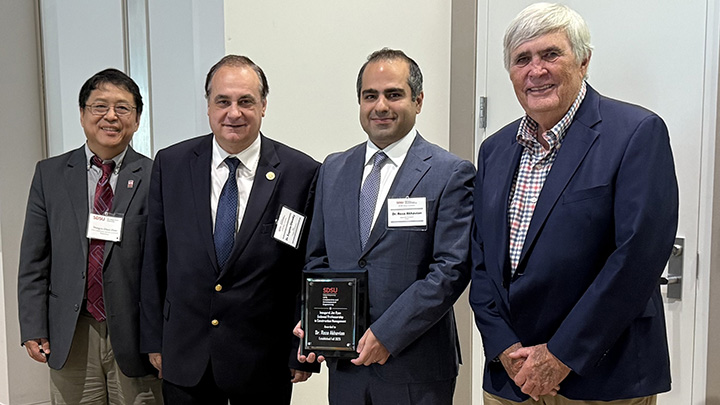Celebrating Black History: A Place At The Table
The Seated at the table of the “The Black in Crimson and Black” mural on the first floor of the University Library are seven black luminaries who made significant contributions to the university’s history.

But if you look closer at the picture, there’s more to the story.
A megaphone, a calculator, the clothing, the colors, the hand gestures, how the figures are seated at the table — even the table itself – have a meaning, a purpose, said one of the mural’s co-creators.
The mural was unveiled in November as part of the university’s 125th anniversary celebration.
“We were given a list of seven people, and then from there, we did some research on them and added their symbolism into the mural,” said Sabrina Davidson, who created the mural with fellow alumna Avia Ramm. “So, you have quite a few moments here … that could tell you more about who they were.”
“They” include Henrietta Goodwin, the first Black student to graduate from the university’s predecessor, the San Diego Normal School, in 1913; E. Walter Miles, the late longtime political science professor known affectionately as the “Godfather of Black Faculty” at SDSU; Harold “Hal” K. Brown, who became the university’s first black administrator in the 1970s and established the Afro-American Studies program in 1972 – one of the first of its type.
There’s also Shirley Weber, a professor and later department chair who became a giant on campus before her ascent to the top echelon of California government as secretary of state; the late Charles Bell, a mathematician who became the university’s second Black professor in 1958; drag icon and activist Amber St. James; and former longtime professor, dean of the College of Education and interim provost Joseph Johnson.
The 16-by-8-foot mural, painted in an array of red, aquamarine and buff white hues of acrylic paint, depicts its seven figures literally with a place at the table, windows onto the SDSU campus behind them.
The genesis of the mural dates back to Juneteenth 2020 in the wake of the protests following the deaths of George Floyd, Breonna Taylor and Ahmaud Arbery.
SDSU released a 10-point plan to enhance support for Black students, faculty, and staff on Juneteenth, including a partnership with Arts Alive SDSU, calling on the partnership to design and facilitate “three placemaking projects across the campus that addressed the history and contributions of Black people and communities.”
J. Luke Wood, vice president of Student Affairs and Campus Diversity, directly requested the library mural, which cost $15,000. Wood, in concert with the African American Alumni Chapter of SDSU and retired SDSU librarian Robert Fikes, selected the alumni that would appear in the art. Fikes is the author of a book detailing the contributions of SDSU Black alumni, "The Black in Crimson and Black.”
“As an administration, we committed to fostering physical environments that demonstrate that our university is a place of belonging and home for our Black community,” Wood said. “We want students to see themselves in the history of this institution and the important strides SDSU has made to transform our local community and the nation.”
Davidson was the first student to apply for the institute’s “Make Your Mark” program, a program started by Buckley that encouraged student artists to create art on the walls of the institute.
A 2021 graduate from Dallas, Texas, Davidson said she was honored to be a part of the “inspiring” project. As a Black woman who attended the university, she said, representation matters.
“I appreciate not only the representation, but it also shows that we have done some amazing things,” Davidson said. “I didn’t realize some of our accomplishments on campus until this project came along. I hope that other students will see it and know they are not alone and that so much that has happened in our history here. We have a legacy.”
Ramm, who graduated in 2020, created a powerful mural in the School of Art and Design, which she proposed to honor the global protests against systemic racism in the summer of 2020. Completed last year, the mural is displayed on an interior wall of the Art South building.
“Together, their experience, dedication, and enthusiasm was a great fit,” said Annie Buckley, a professor in the School of Art and Design and director of the Institute for the Arts, Humanities, and Social Justice, who has partnered with the Division of Student Affairs and Campus Diversity to plan and coordinate the mural. “Their styles are representational but a bit more expressionistic than initially planned. I like how they have added symbolism and color to support the narratives of each subject included.”
One of the first things that stands out about the mural is the color scheme. Crimson, rather than the scarlet seen around SDSU today, was used. Davidson said this was a nod to the university’s history; crimson was the red of choice in previous eras on campus.
“We noticed that the red might not be crimson when you look around now, but back then, when they were working on color schemes, it was crimson and black,” Davidson said. “Along the way, crimson has played a part in the color scheme of SDSU’s history.”
Some of the symbols on the table are fairly literal.
A bouquet of flowers at the center of the table alludes to the saying “give them their flowers,” or, to pay homage to them.
There’s a megaphone on the table, next to Brown, a nod to his role as a prominent civil rights activist in San Diego. Brown frequently used a megaphone when speaking to crowds at civil rights protests.
And a calculator next to Bell represented his career in mathematics.
But there’s other symbolism that’s more subtle.
Brown makes a gesture with his hand in the shape of a “9,” the hand symbol representing the “Divine 9,” the name for the National Pan-Hellenic Council, which comprises the nation’s nine historically black fraternities and sororities. Brown was a member of Kappa Alpha Psi Fraternity Inc.
Toward the rear of the picture, Weber has her hand placed on Miles shoulder, clasping Miles hand. This, Davidson said, symbolizes togetherness and community.
St. James - the youngest figure on the mural - has her hand placed on the right shoulder of Goodwin, SDSU’s first black student, symbolizing the past ushering in the future.
And, finally, Weber, Goodwin and St. James are centrally placed in the mural.
“We want to show that they are the center,” Davidson said. “And it’s w-o-m-x-n, because we’re talking about adding Amber’s power in there.”



